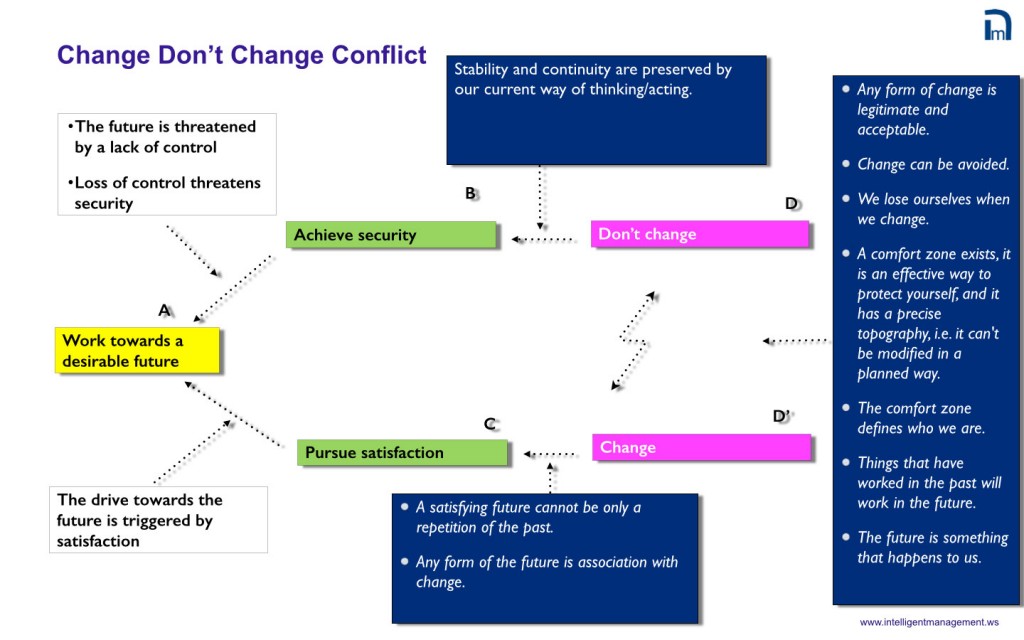Change is hard and decision making can be exhausting. This systemic approach to decision-making helps company leaders move beyond instinctive reactions toward deliberate strategy.

Image courtesy ofJan Genge
Why Change Feels So Hard (Even When We Know It’s Necessary)
Company leaders face a peculiar challenge: while your business environment shifts constantly, your brain actively resists the very changes needed to thrive.
Consider this biological reality. Your body regenerates continuously—pancreatic cells refresh every 24 hours, stomach lining rebuilds every three days, white blood cells renew in ten days. Nearly all brain proteins turn over within a month. Your skin sheds 100,000 cells per minute. Physical transformation is your natural state.
Yet when it comes to how you think, adapt, and make decisions? That’s where resistance lives.
The Mental Models Trap: What’s Really Blocking Your Company’s Growth
Every business leader operates from mental models—ingrained assumptions about how the world works. Some keep you safe. You assume the ground exists when you step out your door. You trust that suppliers will deliver, that customers will pay.
Other mental models silently limit your business potential. They narrow your perception of what’s possible and restrict the solutions you can even imagine.
For SME owners juggling operations, cash flow, and growth simultaneously, these invisible assumptions become especially dangerous. They keep you trapped in firefighting mode rather than building sustainable systems.
The Two Forces Competing for Every Business Decision
Two fundamental drives shape how you learn and act as a business leader:
1. The Drive for Control (Physical Security)
This originates from primal survival instincts. In business terms, it manifests as the need to manage risk, maintain predictability, and protect what you’ve built. Your defining experiences, like past failures, market crashes, cash flow crises, strengthen this drive.
Control isn’t inherently negative. SMEs need financial discipline, operational systems, and risk management. Problems arise when the need for control dominates every decision, paralyzing you from necessary adaptation.
2. The Drive for Vision (Transcendent Meaning)
This represents your innate desire to build something greater than today’s reality. It’s what made you start your business in the first place. Vision pulls you toward innovation, market expansion, and transformational growth.
For company leaders, vision provides the “why” that sustains you through difficult quarters and competitive pressures. It connects daily operations to meaningful impact.
How These Drives Create Decision Paralysis
When you face a significant business decision, like hiring a key person, entering a new market, implementing new technology, these drives collide.
Control transforms into Security: “Don’t make this change. It’s risky. You might fail. Stay with what works.”
Vision transforms into Satisfaction: “Make this change. Growth requires it. You’ll stagnate otherwise.”
This creates the fundamental dilemma every company leader faces: Change vs. Maintain Status Quo.
The Hidden Cost of Undesirable Effects
Decision urgency typically emerges when your current reality shows clear problems. The Theory of Constraints calls these “Undesirable Effects.” For many companies, these might include:
- Revenue plateaus despite effort increases
- Key employees burning out or leaving
- Profit margins shrinking
- Customer acquisition costs rising
- Operational bottlenecks multiplying
Even without crisis signals, your natural drive toward improvement pushes you to consider transformative decisions.
A Framework for Breaking Decision Deadlock
The Conflict Cloud Thinking Process from the Theory of Constraints provides a systemic approach to navigate any dilemma or situation of blockage that requires decision making. We can use an archetypal example to show how it works. In this case, it is a universal conflict of change vs. don’t change. The boxes D and D’ contain two conflicting “wants”. The box B contains the need we want to protect that pushes us in the direction of D: Don’t change. The box C contains the need we want to protect that pushes us in the direction of D’: Change. The needs in B and C are both legitimate and not in conflict. The box A contains the goal that satisfies both the needs in B and C.

Here’s how to apply it to your company decisions:
State the Security Position (Box D): For example, “Do not make the change—stay with current operations.”
Define the Security Need (Box B): What must you protect? Perhaps: “Maintain financial stability and protect the business from catastrophic risk.”
Define the Satisfaction Need (Box C): What drives growth? Perhaps: “Create meaningful impact and achieve the business’s full potential.”
State the Satisfaction Position (Box D’): For example, “Make the change—invest in growth initiatives.”
Identify Your Goal (Box A): What outcome would satisfy both security and satisfaction? For example: “Build a profitable, sustainable business that grows without consuming my entire life.”
Uncovering the Assumptions That Keep You Stuck
The real breakthrough comes from examining the assumptions connecting these elements:
Why does security require avoiding change?
- “Change always brings unpredictable problems”
- “We don’t have resources to handle complications”
- “Our current approach is proven safe”
Why does satisfaction require making change?
- “Growth is impossible without transformation”
- “Market conditions demand adaptation”
- “Staying still means falling behind”
Why are these positions mutually exclusive?
- “We can’t maintain stability while changing”
- “Change requires resources we don’t have”
- “One approach must be chosen over the other”
Challenging Assumptions Opens New Paths
When you systematically question these assumptions, alternatives emerge:
What if you could pilot changes in controlled ways? What if you could build stability through strategic adaptation rather than despite it? What if small iterative changes reduce risk more than maintaining rigid systems?
For SMEs specifically, what if the greatest security comes from building adaptable systems rather than protecting static processes?
Implementing Systemic Decision-Making in Your SME
Step 1: Map Your Next Major Decision Write out your specific dilemma using the conflict cloud structure. Be brutally honest about both the security concerns and growth aspirations.
Step 2: List Every Assumption Document what you believe to be true about each need and position. Don’t filter—capture even “obvious” assumptions.
Step 3: Challenge Each Assumption For every assumption, ask: “Is this always true? Under what conditions might it be false? What evidence supports or contradicts it?”
Step 4: Identify Integrated, Systemic Solutions Identify approaches that invalidate the assumptions between the conflicting positions in D and D’ and that address both needs simultaneously rather than choosing one over the other.
Step 5: Build Decision-Making Capacity Train your leadership team in this framework. Make it your standard approach for significant choices.
Moving from Reactive to Strategic Leadership
The archetypal change conflict isn’t something you resolve once. It recurs with every significant decision your SME faces.
The difference between business owners who build thriving, sustainable enterprises and those perpetually firefighting often comes down to decision-making methods.
By recognizing the security-satisfaction dynamic, mapping conflicts explicitly, and challenging limiting assumptions, you transform decision-making from an anxiety-inducing burden into a structured capability.
Your business’s constant physical changes—market shifts, customer needs, competitive pressures—will continue. The question is whether your decision-making processes will evolve to match that reality.
Key Takeaways for Company Leaders
- Your resistance to business change is neurological, not logical—recognize it as a pattern to work with, not overcome through willpower alone
- Every major decision involves balancing control (security) with vision (satisfaction)
- The conflict isn’t about right and wrong choices, but invalidating flawed assumptions that keep you stuck
- Assumptions linking needs to positions hold the key to breakthrough solutions
- Systematic decision-making frameworks prevent analysis paralysis and reactive firefighting
- Building this capacity in your leadership team multiplies your business’s adaptive capability
This systemic approach to decision making helps company leaders move beyond instinctive reactions toward deliberate strategy. When you understand the deeper dynamics driving your choices, you can build businesses that thrive amid constant change rather than despite it.
At Intelligent Management we’ve helped companies embed the Thinking Processes into their day-to-day to think and plan systemically since 1996. Contact us to learn how to power your sustainable growth with a robust and repeatable method. Reach out to us at intelligentmanagement@sechel.ws or through our online form here: https://intelligentmanagement.ws/contact-us/

ntelligent Management works with decision makers with the authority and responsibility to make meaningful change to optimize your company for the digital age. We have helped dozens of organizations to adopt a systemic approach to manage complexity and radically improve performance and growth for over 25 years through our Decalogue management methodology. The Network of Projects organization design we developed is supported by our Ess3ntial software for multi-project finite scheduling based on the Critical Chain algorithm.
See our latest books: The Human Constraint from Routledge; From Silos to Networks: A New Kind of Science for Management from Springer; Moving the Chains: An Operational Solution for Embracing Complexity in the Digital Age by our Founder Dr. Domenico Lepore, and ‘Quality, Involvement, Flow: The Systemic Organization’ from CRC Press, New York by Dr. Domenico Lepore, Dr. Angela Montgomery and Dr. Giovanni Siepe.





Leave a Reply